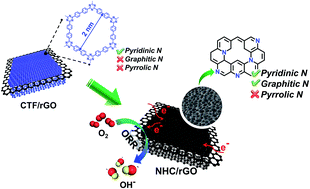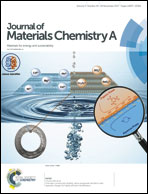From covalent triazine-based frameworks to N-doped porous carbon/reduced graphene oxide nanosheets: efficient electrocatalysts for oxygen reduction†
Abstract
By selecting 4,4′-dicyanobiphenyl (DCBP) as a building block, porous covalent triazine-based frameworks (CTFs) incorporating pyridinic N only have been deliberately fabricated. Upon pyrolysis, the CTF-templated N-doped and hierarchically porous carbons (NHCs) exhibit high surface area, adjustable pore structure and well-controlled doping of pyridinic and graphitic N species. The above CTFs have been rationally grown onto highly conductive reduced graphene oxide (rGO) to afford CTF/rGO hybrids. The subsequent pyrolysis gives sandwich-like NHC/rGO composites, which synergistically integrate respective advantages of both the components of NHC and rGO, thus offering excellent electrocatalytic performance for the oxygen reduction reaction (ORR). Significantly, the resultant NHC/rGO-950 exhibits a more positive onset and half-wave potential, higher diffusion-limited current density and better long-term stability than the state-of-the-art Pt/C and is among the best of previously reported metal-free electrocatalysts, in alkaline solution. Such rGO-templated NHCs based on CTFs offer a promising strategy to design highly efficient metal-free ORR electrocatalysts for fuel cells.



 Please wait while we load your content...
Please wait while we load your content...